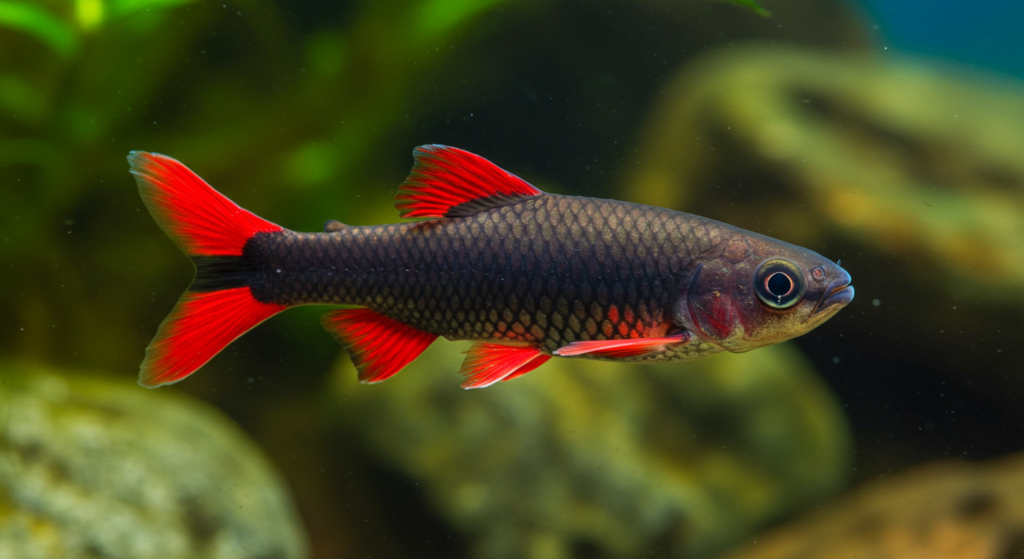Table of Contents
- Introduction
- Appearance and Characteristics
- Natural Habitat
- Tank Requirements
- Water Conditions
- Diet and Feeding
- Behavior and Tank Mates
- Breeding
- Common Health Issues
- Conclusion
- FAQs
Introduction
The Red-Tailed Shark (Epalzeorhynchos bicolor) is a striking freshwater fish known for its vibrant red tail and sleek black body. Despite its name, it is not a true shark but belongs to the Cyprinidae family. Popular among aquarists for its bold personality, this fish requires specific care to thrive in captivity. This guide covers everything from tank setup to diet, ensuring a healthy environment for your Red-Tailed Shark.

Appearance and Characteristics
The Red-Tailed Shark has a deep black body with a bright red or orange tail fin, making it a standout in any aquarium. It grows up to 6 inches (15 cm) in length and has a streamlined, torpedo-shaped body. Its dorsal fin is tall and pointed, resembling a shark’s fin, which contributes to its name.
Natural Habitat
Native to Thailand’s river basins, the Red-Tailed Shark thrives in fast-flowing, oxygen-rich waters with rocky or sandy substrates. Unfortunately, due to habitat destruction, it is considered critically endangered in the wild, making captive breeding essential for its survival.
Tank Requirements
To keep a Red-Tailed Shark healthy, provide the following tank conditions:
- Minimum Tank Size: 55 gallons (for a single fish)
- Substrate: Sand or fine gravel
- Decorations: Rocks, caves, and driftwood for hiding
- Plants: Hardy species like Java Fern or Anubias
- Filtration: Strong water flow to mimic natural currents
Water Conditions
Maintain optimal water parameters for a thriving Red-Tailed Shark:
- Temperature: 72°F – 79°F (22°C – 26°C)
- pH Level: 6.5 – 7.5
- Water Hardness: 5 – 15 dGH
- Ammonia/Nitrites: 0 ppm
- Nitrates: < 20 ppm
Diet and Feeding
The Red-Tailed Shark is an omnivore with a preference for:
- High-quality pellets/flakes
- Live or frozen foods (bloodworms, brine shrimp)
- Vegetables (zucchini, spinach)
Feed twice daily in small portions to prevent overfeeding.
Behavior and Tank Mates
This species is territorial, especially toward its own kind. Ideal tank mates include:
- Barbs
- Danios
- Rainbowfish
- Larger Tetras
Avoid slow-moving or long-finned fish, as the Red-Tailed Shark may become aggressive.
Breeding
Breeding in captivity is rare but possible with:
- Separate breeding tank
- Slightly warmer water (80°F)
- Plenty of hiding spots
Females lay eggs on flat surfaces, which hatch in 2-3 days.
Common Health Issues
Watch for:
- Ich (White Spot Disease) – Treat with increased temperature and medication.
- Fin Rot – Improve water quality and use antibacterial treatments.
- Stress-Related Diseases – Ensure proper tank conditions and compatible tank mates.
Conclusion
The Red-Tailed Shark is a captivating yet demanding fish that thrives in well-maintained aquariums. With proper care, a suitable environment, and a balanced diet, this species can live up to 5-8 years. Always monitor water conditions and behavior to ensure a healthy, stress-free life for your fish.
FAQs
1. Can Red-Tailed Sharks live with other sharks?
No, they are highly territorial and will fight with similar-looking fish, including other Red-Tailed Sharks.
2. How big do Red-Tailed Sharks get?
They typically grow up to 6 inches (15 cm) in length.
3. Are Red-Tailed Sharks aggressive?
They can be territorial, especially in small tanks. Provide ample space and hiding spots to reduce aggression.
4. What is the lifespan of a Red-Tailed Shark?
With proper care, they can live 5-8 years.
5. Do Red-Tailed Sharks eat plants?
They may nibble on soft plants but prefer algae and meaty foods.
